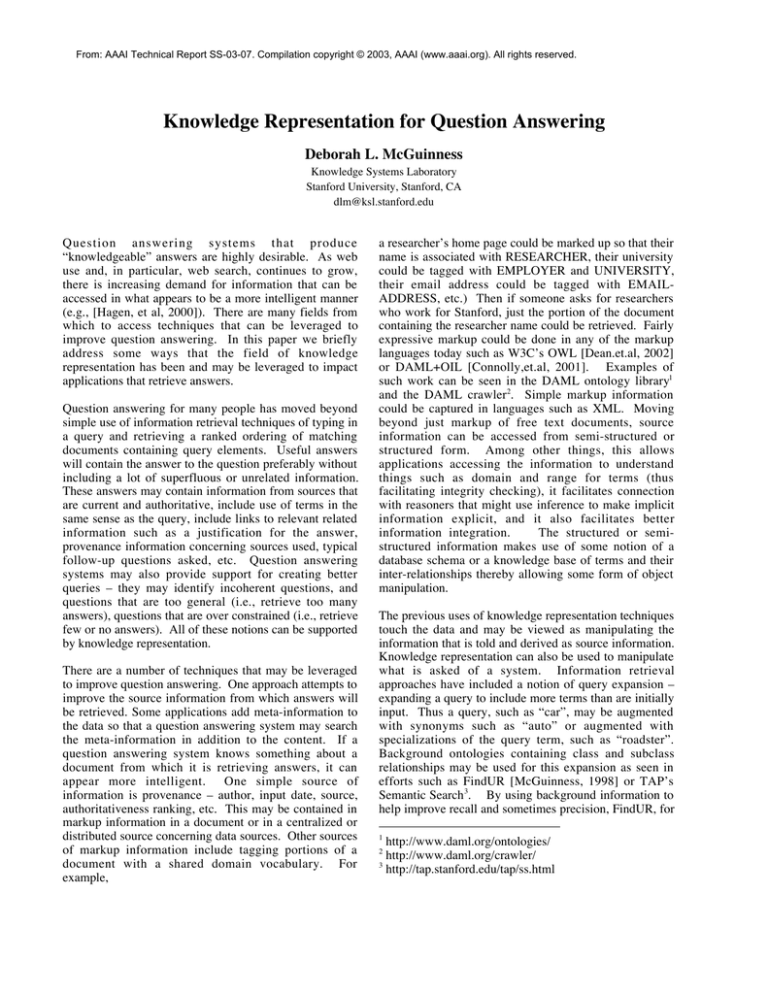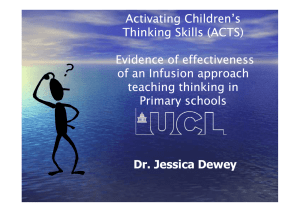
From: AAAI Technical Report SS-03-07. Compilation copyright © 2003, AAAI (www.aaai.org). All rights reserved.
Knowledge Representation for Question Answering
Deborah L. McGuinness
Knowledge Systems Laboratory
Stanford University, Stanford, CA
dlm@ksl.stanford.edu
Question answering systems that produce
“knowledgeable” answers are highly desirable. As web
use and, in particular, web search, continues to grow,
there is increasing demand for information that can be
accessed in what appears to be a more intelligent manner
(e.g., [Hagen, et al, 2000]). There are many fields from
which to access techniques that can be leveraged to
improve question answering. In this paper we briefly
address some ways that the field of knowledge
representation has been and may be leveraged to impact
applications that retrieve answers.
Question answering for many people has moved beyond
simple use of information retrieval techniques of typing in
a query and retrieving a ranked ordering of matching
documents containing query elements. Useful answers
will contain the answer to the question preferably without
including a lot of superfluous or unrelated information.
These answers may contain information from sources that
are current and authoritative, include use of terms in the
same sense as the query, include links to relevant related
information such as a justification for the answer,
provenance information concerning sources used, typical
follow-up questions asked, etc. Question answering
systems may also provide support for creating better
queries – they may identify incoherent questions, and
questions that are too general (i.e., retrieve too many
answers), questions that are over constrained (i.e., retrieve
few or no answers). All of these notions can be supported
by knowledge representation.
There are a number of techniques that may be leveraged
to improve question answering. One approach attempts to
improve the source information from which answers will
be retrieved. Some applications add meta-information to
the data so that a question answering system may search
the meta-information in addition to the content. If a
question answering system knows something about a
document from which it is retrieving answers, it can
appear more intelligent. One simple source of
information is provenance – author, input date, source,
authoritativeness ranking, etc. This may be contained in
markup information in a document or in a centralized or
distributed source concerning data sources. Other sources
of markup information include tagging portions of a
document with a shared domain vocabulary. For
example,
a researcher’s home page could be marked up so that their
name is associated with RESEARCHER, their university
could be tagged with EMPLOYER and UNIVERSITY,
their email address could be tagged with EMAILADDRESS, etc.) Then if someone asks for researchers
who work for Stanford, just the portion of the document
containing the researcher name could be retrieved. Fairly
expressive markup could be done in any of the markup
languages today such as W3C’s OWL [Dean.et.al, 2002]
or DAML+OIL [Connolly,et.al, 2001]. Examples of
such work can be seen in the DAML ontology library1
and the DAML crawler2. Simple markup information
could be captured in languages such as XML. Moving
beyond just markup of free text documents, source
information can be accessed from semi-structured or
structured form. Among other things, this allows
applications accessing the information to understand
things such as domain and range for terms (thus
facilitating integrity checking), it facilitates connection
with reasoners that might use inference to make implicit
information explicit, and it also facilitates better
information integration.
The structured or semistructured information makes use of some notion of a
database schema or a knowledge base of terms and their
inter-relationships thereby allowing some form of object
manipulation.
The previous uses of knowledge representation techniques
touch the data and may be viewed as manipulating the
information that is told and derived as source information.
Knowledge representation can also be used to manipulate
what is asked of a system. Information retrieval
approaches have included a notion of query expansion –
expanding a query to include more terms than are initially
input. Thus a query, such as “car”, may be augmented
with synonyms such as “auto” or augmented with
specializations of the query term, such as “roadster”.
Background ontologies containing class and subclass
relationships may be used for this expansion as seen in
efforts such as FindUR [McGuinness, 1998] or TAP’s
Semantic Search 3. By using background information to
help improve recall and sometimes precision, FindUR, for
1
http://www.daml.org/ontologies/
http://www.daml.org/crawler/
3
http://tap.stanford.edu/tap/ss.html
2
example was able to take an electronic yellow pages
application and improve its recall over 300 percent.
Ontologies may benefit queries in ways other than just
query expansion; they can also be used to help analyze
and refine queries. Queries that have terms from a
background ontology may be analyzed to determine their
interrelationships (e.g., IMACS [Brachman, et.al, 1993]).
For example, a query for “sports cars” can be determined
to be more specific than a query for “autos” assuming a
background ontology containing the synonyms “auto” and
“car” and the “sports car”-“car” subclass relationship. If a
query is entered that is too general, such as “auto” on a
car web site, subclasses of car may be offered to the user
to help refine a query. Similarly a query that is overconstrained such as sports cars that cost less than three
thousand dollars could be analyzed and generalizations
may be offered such as “cars that cost less than three
thousand dollars” or “sports cars that cost less than x”
where x is noticeably greater than 3000. Ontologies may
be used in a number of other ways as well to help refine
queries, select portions of answers or documents to return,
help crawl free text to generate semi-structured text, etc.
[McGuinness, 2003].
Answers may also be improved with some knowledge
representation techniques. Answers may include the
ability to return identified information that satisfies a
query specification.
Document retrieval systems
typically do not identify the portion of the document (i.e.
the document object(s)) that contains the answer.
Today’s agent or human user who asks for universities in
Santa Clara County for example, does not just want
documents including “Stanford University” or “UCSC”
(or the university name and its address), they want the
identified object representing Stanford University or
UCSC, along with the option of accessing object
properties such as the address, the county of the object,
the source of that information, relationships between the
object and other objects such as the university’s student
population, etc.
Also, answers can be enhanced with optional
justifications including information such as why Stanford
is retrieved, where the data came from, if inferences were
made, how they were deduced, etc. Inference Web
[McGuinness-Pinheiro da Silva, 2003], for example, uses
a background portable proof specification that allows
information sources and reasoners to provide optional
justifications for any answers that they return in a
portable, machine-understandable, and distributed
“proof”. Then the inference web browser allows other
programs to access those proofs and also allows humans
to use a browser to view the justifications. Thus humans
or agents can obtain access to information such as author,
recency, and deductive process used in order to help
decide if the information should be trusted and how it
should be used. This can be particularly useful when
agents or humans receive conflicting answers and want to
know which to trust or if humans are attempting to reuse
past answers and they want to examine the assumptions
and sources used before relying on the information again.
Answers may also be pruned for presentation if an answer
is too long or complicated. Pruning or matching
languages such [Baader, et.al, 1999] have been used to
ask for answers with a number of constraints needing to
be satisfied. It is simultaneously used to filter out pieces
of an answer that are considered irrelevant. The KR
language allows variables in the query and then bindings
for those variables are returned subject to pruning
specification information stored in an ontology.
Customized answers may also be constructed based on
knowledge of the query and/or the answer. One simple
way to enhance answers is to provide optional
background information in a consistent manner. The
background information may be simple definitional
information such as simple ontology descriptions or
previously constructed web pages for common term
information. Hyper-linking to definitional information
can be seen today in products such as Sentius’ Richlink1.
It allows an application to maintain background
information associated with words, phrases, or metainformation to help decide which link to use for hyperlinking or additional link presentation. The links can be
used with simple controlled vocabularies or more
structured ontologies. Links can also be chosen for
presentation taking context into account. This approach
can be used for background information (optional
definitional links) or for related links. For example, if a
search is done for a term that is known to be a performing
artist, links can be supplied for the preferred page for
performing artist as well as considering optional links for
concerts in a near future time period and local geographic
location if location is known.
Initial work on the approach including related links can
be seen with many search engines (e.g., Google2,
AltaVista3) when they return matching documents in the
main portion of the screen and provide selected (typically
sponsored) links on the right with related information
such as albums that can be purchased by the performing
artist or books about or by the performer. Tap’s Activitybased search4 takes this a step further adding links and
content on the right side of the display screen from a
knowledge base containing structured information
concerning activities that the term participates in. It then
chooses right side links from activities in which the term
participates instead of choosing links according to what
terms have been purchased. For example, activities
1
2
3
4
http://www.sentius.com/
http://www.google.com/
http://www.altavista.com/
http://tap.stanford.edu/tap/ss.html
associated with performers include concert schedules,
albums, posters, and biographies and all may be provided
as optional portions for hyper-linking use with returned
answers.
The talk accompanying this paper will provide examples
of the knowledge-enhanced techniques used in
applications such as search, data mining, configuration,
ontology environments, and explanation systems. We
address ways KR can help in storing, accessing,
presenting, justifying, and filtering answers as well as in
analyzing and improving queries.
References
[Baader,et.al, 1999] Baader, Borgida, Kuesters, and
McGuinness. Matching in Description Logics. In Journal
of Logic and Computation – Special Issue on Description
Logics. Volume 9, number 3, June 1999.
[Brachman,et.al., 1993] Brachman, Selfridge, Terveen,
Altman, Borgida, Halper, Kirk, Lazar, McGuinness,
Resnick. ``Integrated Support for Data Archaeology.'' In
International Journal of Intelligent and Cooperative
Information Systems, 2:2 1993, pages 159--185.
[Connolly,et.al, 2001] Connolly, van Harmelen,
Horrocks, McGuinness, Patel-Schneider, Stein, eds.
DAML+OIL Reference Description, 2001.
http://www.w3.org/TR/
daml+oil-reference.
[Dean,et.al, 2002] Dean, Connolly, van Harmelen,
Hendler, Horrocks, McGuinness, Patel-Schneider, Stein.
Eds. Web Ontology Language (OWL) Reference Version
1.0, 2002 http://www.w3.org/TR/2002/WD-owl-ref20021112/
[Hagen,et.al, 2000] Hagen, Manning, and Paul. ”Must
Search Stink“ Forrester Research TechStrategy Briefing,
June 2000.
[McGuinness, 1996]
McGuinness.
“Explaining
Reasoning in Description Logics”. Ph.D. Thesis, Rutgers
University, 1996. Technical Report LCSR-TR-277.
[McGuinness, 1998] McGuinness. ``Ontological Issues
for Knowledge-Enhanced Search''. In the Proceedings of
Formal Ontology in Information Systems, June 1998.
Also in Frontiers in Artificial Intelligence and
Applications, IOS-Press, Washington, DC, 1998.
[McGuinness, 2003]. McGuinness. ``Ontologies Come
of Age''. In Dieter Fensel, Jim Hendler, Henry Lieberman,
and Wolfgang Wahlster, editors. Spinning the Semantic
Web: Bringing the World Wide Web to Its Full Potential.
MIT Press, 2002.
http://www.ksl.stanford.edu/
people/dlm/papers/ontologies-come-of-age-abstract.html .
[McGuinness-Pinheiro da Silva, 2003] McGuinness and
Pinheiro da Silva. Inference Web: Portable and Shareable
Explanations for Question Answering ''. In Proc. AAAI
Spring Symposium on New Directions for Question
Answering. Stanford, CA. March 2003.



